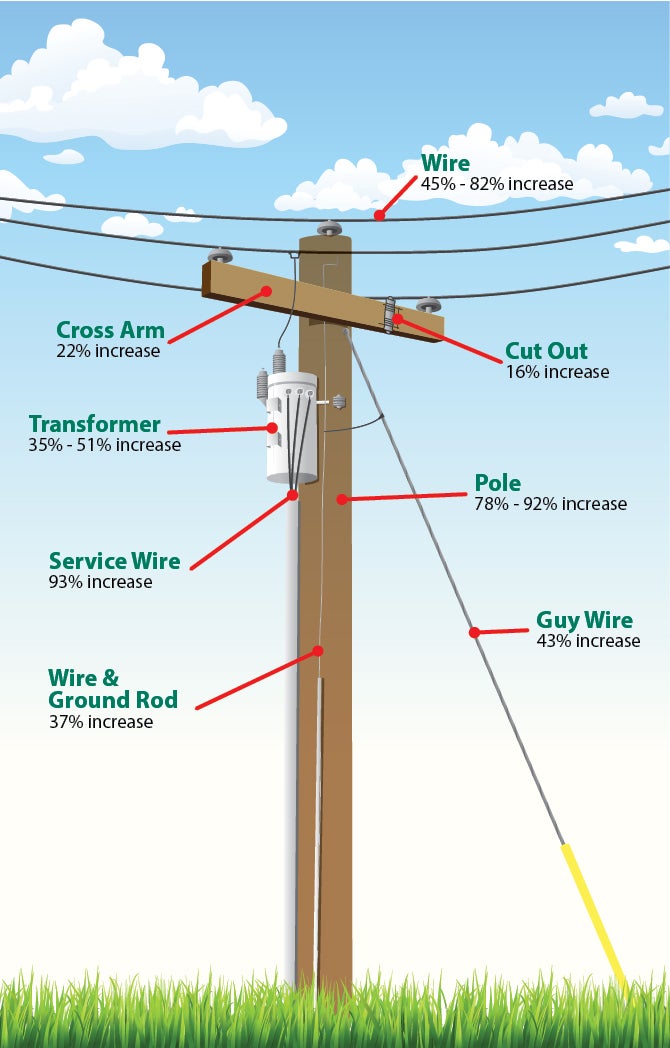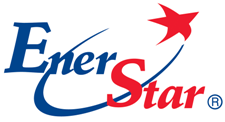
Utilities everywhere are feeling pressure when it comes to continuing supply chain slowdowns and skyrocketing costs of fuel and materials for our daily business needs. This situation is not unique to EnerStar. Regardless, it is concerning and something your cooperative takes seriously. Another thing we take seriously is providing you with safe, reliable and affordable electricity. It’s our commitment to each member. It is our mission.
Increasing costs
According to the Consumer Price Index, inflation in the Midwest has been pushing 30% for the last decade. You may not be able to quote that number, but all of us are feeling its effects, whether it is a gallon of milk or a gallon of gasoline.
The best way to explain the current situation of rising material costs is the accompanying illustration. This graphic shows some of the drastic changes in utility equipment prices that EnerStar has experienced over the last two years. It really has been astonishing.
In addition, EnerStar relies heavily on diesel fuel for its trucks, and no doubt you have seen in the news the problems with diesel. Our cost of fuel has been from 33% to 128% higher during the same time period.
The average residential account will only see a 50-cent increase per month.
Planning
EnerStar is diligent when it comes to operating costs. We analyze data forecasts and trends to prudently manage your cooperative. Each year begins with a budget. Upcoming construction and maintenance projects are planned.
One part of the planning process is a move towards cost-based rates. An outside consulting firm conducts a “Cost of Service” study (COSS) on behalf of the cooperative. The study is an important tool for setting our utility rates, as it fairly and equitably breaks down the costs of providing service to each rate class. Different kinds of users have different load characteristics and configurations they need. The COSS findings offer useful guidelines to assist the board in reasonably and responsibly allocating costs to each class of members in a way that avoids any class paying more, or less, than their fair share.
Rate changes
According to the COSS, and due to rising costs, changes are needed in our electric rates. Therefore, beginning in February, EnerStar will have a rate change and restructuring for single-phase accounts. There are two parts to this restructuring:
- The Grid Access Fee will increase by $5 per month.
- The Power Cost Adjustment will decrease by about .00441 per kWh.
Effect of the restructuring
The average residential account uses about 1,100 kilowatt hours per month. In this instance, the consumer will see very little change to their billing statement. In fact, the average residential account will only see a 50-cent increase per month.
Even with significant improvements made to the electric system, EnerStar’s rates have only increased on average less than one percent per year since 2013.
You may be asking at this point about historical electric rates at EnerStar. And the story reflects the diligence of the cooperative staff and board of directors efforts over the years.
Let’s compare:
- In 2013, the average billing on the average residential account was $175.75.
- In 2023, that amount will be $186.74.
- That is just a 6.4% increase over the last 10 years.
It is a powerful story of doing more with less. About being diligent. During that time when rate increases have been kept to a minimum, EnerStar has made significant investments in continuing to improve our electric system. Upgrading conductors and replacing poles are critical but just as important is the cooperative’s commitment to responsible vegetation management. And it shows. Our outage statistics have greatly improved. Members are telling us they have noticed the results as well.
We do not take rate changes lightly, and will continue to communicate with you throughout the year on our future plans.
What is a “Grid Access Fee,” anyway?
When we discuss service availability, population density is at the heart of the matter. We distribute power to members living in the rural portions of our five-county service area through over 1,500-plus miles of electric lines. We are sparsely populated in portions of those counties. In fact, we are the third most “rural” electric cooperative in Illinois with just 3.5 members per mile of line. Compare that to an investor-owned utility or a municipal utility that may have 40 to 60 consumers to share the costs of that same mile of line.
Regardless of the number of members per mile of line, we must purchase and maintain poles, conductors and transformers throughout our entire service area. This is necessary not only to make electric service available but to keep it reliable no matter how far off the beaten path.
To make service available to all members, cooperatives need to have some form of service availability charge. We call this the “Grid Access Fee.” This charge helps cover the minimum fixed costs that are required to deliver service to every meter on the system — costs that remain the same no matter how much electricity is sold. Some of the fixed costs include maintaining right-of-way; trucks and equipment; poles, meters and wires; and computer systems and software.
Think of the service availability charge like this: If you own a car, you pay insurance, license and taxes whether you drive every day or once a year. Fixed charges are like those expenses that come with your car. It is there, ready and waiting, so in that millisecond when you flip the switch, you have the power you want or need.
